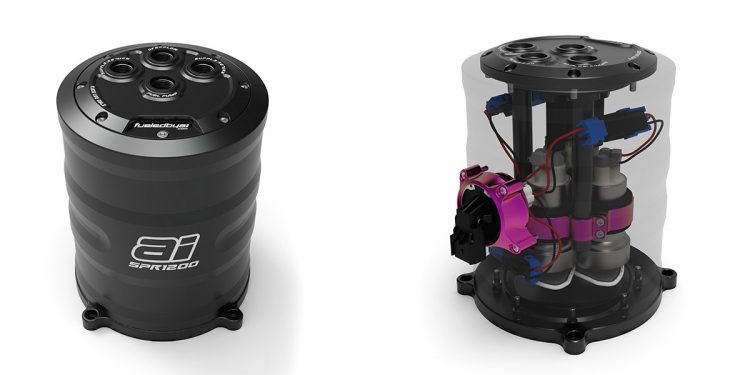As you probably already know, your engine needs three things to create combustion: oxygen, fuel, and spark. Clean air is supplied by your intake system, the spark is supplied by your spark plugs, and fuel is supplied by your fuel system.
As your increase power output, you increase the need for fuel, and supplying the fuel from the tank to the engine can quickly become complicated for high-horsepower applications. The issue with a standard fuel system is that the fuel pickup tube inside the tank sucks in air if your car is experiencing high lateral acceleration. If this happens, your engine can fuel starve and end up with catastrophic failure.
This is where a Fuel Surge Tank (FST for short) can save the day. By installing a fuel surge tank in your vehicle, you ensure your engine is always supplied the necessary amount of fuel to run properly, even during high lateral acceleration moments such as being on the racetrack or drag strip. To put it simply, if you want to hit the track with your high horsepower car, a fuel surge tank is a must-have modification.
How Does it Work?
A fuel surge tank works by using the flow in your fuel system provided by your fuel lift pump to fill the surge tank. Depending on the type of surge tank you’re using the fuel pumps can be mounted inside or outside the surge tank.
One of the most popular surge tanks on the market, the SPR1200V2 Surge Tank from Fueled By AI, uses 1-3 fuel pumps internally. The amount of internal fuel pumps you opt for is dependent on your current and future power goals. The SPR1200V2 offers a 1-gallon fuel capacity supplied by the lift pump, and that large fuel capacity helps to ensure extra protection from any possibility of fuel starvation.
Why Not Use a Larger In-Tank Fuel Pump?
This is actually a great question. For mild street applications, upgrading your in-tank pump is a totally viable solution, but for high-horsepower vehicles, this isn’t possible without modifying the fuel tank due to the size of the aftermarket fuel pump.
The alternate solution is to run an external fuel pump, but the issue there is that fuel pumps are great at pumping fuel forward, but not great at pulling it from the tank. You can solve this issue by using an in-tank pump to help supply fuel to the larger external fuel pump, but you’re still left with zero protection from air pockets being pumped to the external pump.
The surge tank is effectively just a tank that sits between the in-tank pump and the external pump to prevent the larger fuel pump from being supplied with air instead of fuel. As mentioned above, many surge tanks also move the external fuel pump inside the surge tank itself.
Do I Need a Surge Tank with Internal Fuel Pumps?
Technically no, you can use a surge tank supplied by the in-tank pump and your fuel return system. The big issue with running a large external fuel pump is sound. For a high-horsepower application, an external fuel pump is extremely loud and not daily-driver friendly. By moving the large pump(s) inside the fuel surge tank, you eliminate a lot of that fuel pump noise.




